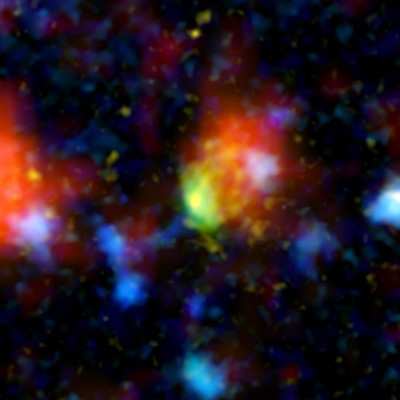Milky Way "Only" Produces 10 Stars A Year; This One Does
4,000
Astronomers recently uncovered an extreme stellar machine -- a
galaxy in the very remote universe pumping out stars at a
surprising rate of up to 4,000 per year. In comparison, our own
Milky Way galaxy turns out an average of just 10 stars per
year.

The discovery, made possible by several telescopes including
NASA's Spitzer Space Telescope, goes against the most common theory
of galaxy formation. According to the theory, called the
Hierarchical Model, galaxies slowly bulk up their stars over time
by absorbing tiny pieces of galaxies -- and not in one big burst as
observed in the newfound "Baby Boom" galaxy.
"This galaxy is undergoing a major baby boom, producing most of
its stars all at once," said Peter Capak of NASA's Spitzer Science
Center at the California Institute of Technology, Pasadena. "If our
human population was produced in a similar boom, then almost all of
the people alive today would be the same age." Capak is lead author
of a new report detailing the discovery in the July 10th issue of
Astrophysical Journal Letters.

The Baby Boom galaxy, which belongs to a class of galaxies
called starbursts, is the new record holder for the brightest
starburst galaxy in the very distant universe, with brightness
being a measure of its extreme star-formation rate. It was
discovered and characterized using a suite of telescopes operating
at different wavelengths. NASA's Hubble Space Telescope and Japan's
Subaru Telescope, atop Mauna Kea in Hawaii, first spotted the
galaxy in visible-light images, where it appeared as an
inconspicuous smudge due to is great distance.
 It
wasn't until Spitzer and the James Clerk Maxwell Telescope, also on
Mauna Kea in Hawaii, observed the galaxy at infrared and
submillimeter wavelengths, respectively, that the galaxy stood out
as the brightest of the bunch. This is because it has a huge number
of youthful stars. When stars are born, they shine with a lot of
ultraviolet light and produce a lot of dust. The dust absorbs the
ultraviolet light but, like a car sitting in the sun, it warms up
and re-emits light at infrared and submillimeter wavelengths,
making the galaxy unusually bright to Spitzer and the James Clerk
Maxwell Telescope.
It
wasn't until Spitzer and the James Clerk Maxwell Telescope, also on
Mauna Kea in Hawaii, observed the galaxy at infrared and
submillimeter wavelengths, respectively, that the galaxy stood out
as the brightest of the bunch. This is because it has a huge number
of youthful stars. When stars are born, they shine with a lot of
ultraviolet light and produce a lot of dust. The dust absorbs the
ultraviolet light but, like a car sitting in the sun, it warms up
and re-emits light at infrared and submillimeter wavelengths,
making the galaxy unusually bright to Spitzer and the James Clerk
Maxwell Telescope.
To learn more about this galaxy's unique
youthful glow, Capak and his team followed up with a number of
telescopes. They used optical measurements from Keck to determine
the exact distance to the galaxy -- a whopping12.3 billion
light-years. That's looking back to a time when the universe was
1.3 billion years old (the universe is approximately 13.7 billion
years old today).
"If the universe was a human reaching retirement age, it would
have been about 6 years old at the time we are seeing this galaxy,"
said Capak.
The astronomers made measurements at radio wavelengths with the
National Science Foundation's Very Large Array in New Mexico.
Together with Spitzer and James Clerk Maxwell data, these
observations allowed the astronomers to calculate a star-forming
rate of about 1,000 to 4,000 stars per year. At that rate, the
galaxy needs only 50 million years, not very long on cosmic
timescales, to grow into a galaxy equivalent to the most massive
ones we see today.
While galaxies in our nearby universe can produce stars at
similarly high rates, the farthest one known before now was about
11.7 billion light-years away, or a time when the universe was 1.9
billion years old.
"Before now, we had only seen galaxies form stars like this in
the teenaged universe, but this galaxy is forming when the universe
was only a child," said Capak. "The question now is whether the
majority of the very most massive galaxies form very early in the
universe like the Baby Boom galaxy, or whether this is an
exceptional case. Answering this question will help us determine to
what degree the Hierarchical Model of galaxy formation still holds
true."

"The incredible star-formation activity we have observed
suggests that we may be witnessing, for the first time, the
formation of one of the most massive elliptical galaxies in the
universe," said co-author Nick Scoville of Caltech, the principal
investigator of the Cosmic Evolution Survey, also known as Cosmos.
The Cosmos program is an extensive survey of a large patch of
distant galaxies across the full spectrum of light.
"The immediate identification of this galaxy with its
extraordinary properties would not have been possible without the
full range of observations in this survey," said Scoville.
 ANN's Daily Aero-Linx (04.15.24)
ANN's Daily Aero-Linx (04.15.24) Classic Aero-TV: 'No Other Options' -- The Israeli Air Force's Danny Shapira
Classic Aero-TV: 'No Other Options' -- The Israeli Air Force's Danny Shapira Aero-News: Quote of the Day (04.15.24)
Aero-News: Quote of the Day (04.15.24) Airborne 04.16.24: RV Update, Affordable Flying Expo, Diamond Lil
Airborne 04.16.24: RV Update, Affordable Flying Expo, Diamond Lil ANN's Daily Aero-Term (04.16.24): Chart Supplement US
ANN's Daily Aero-Term (04.16.24): Chart Supplement US






